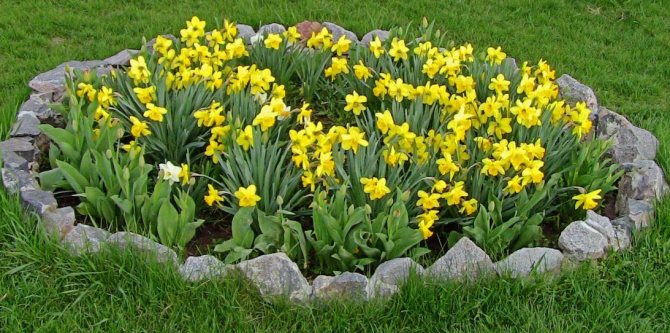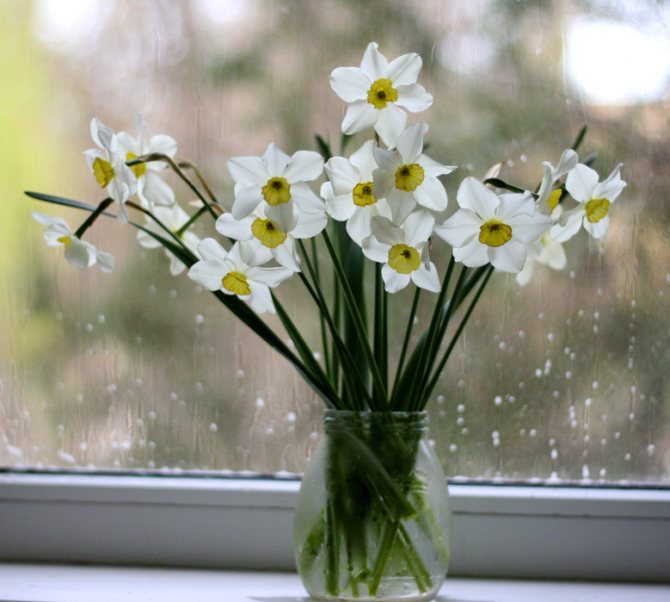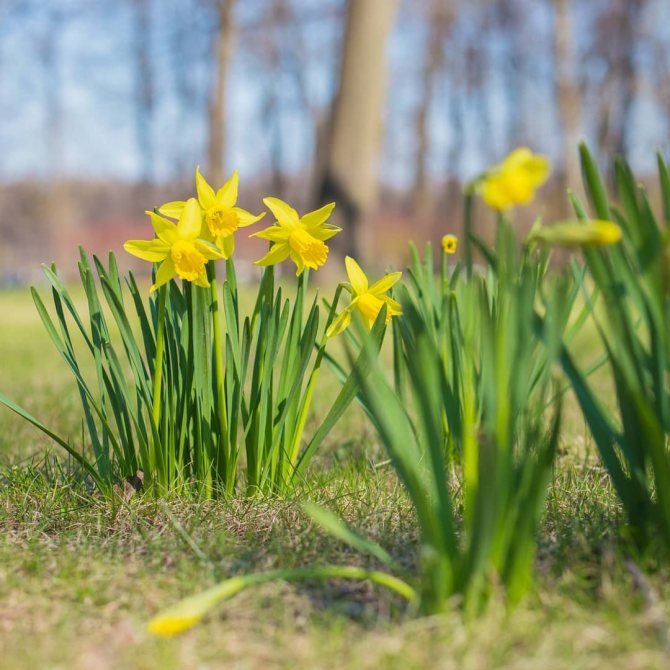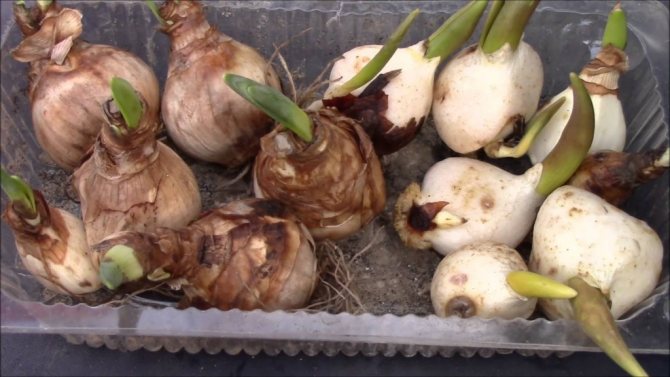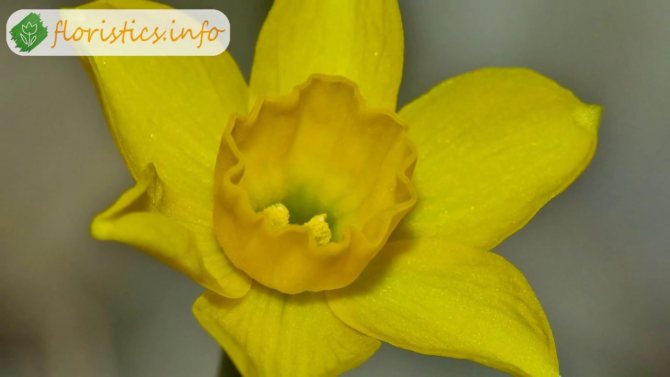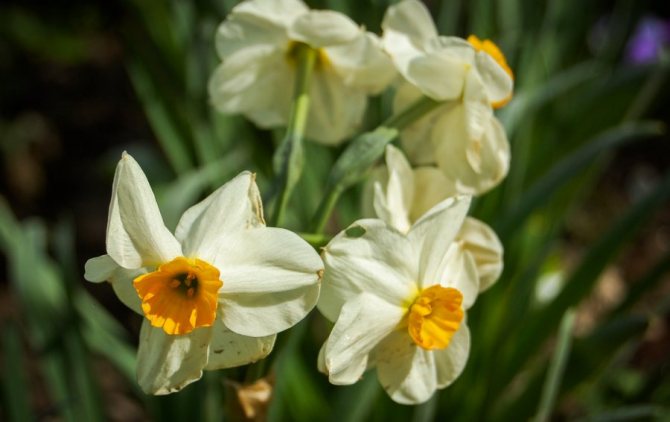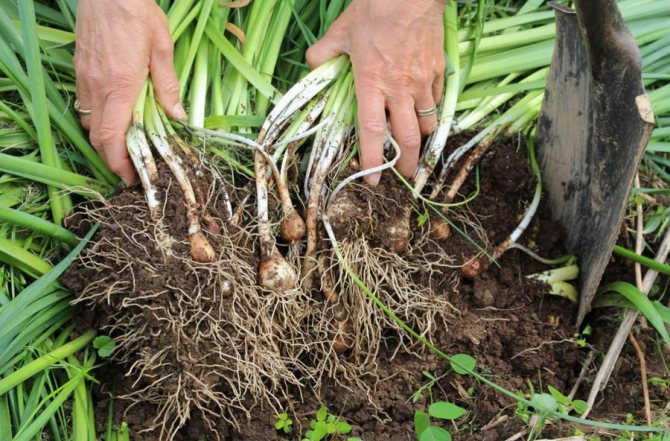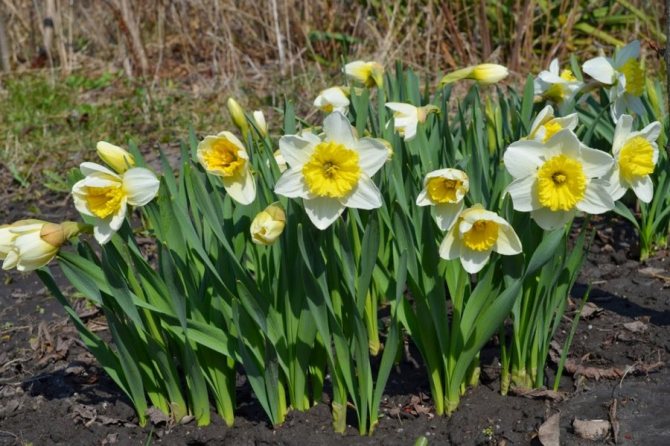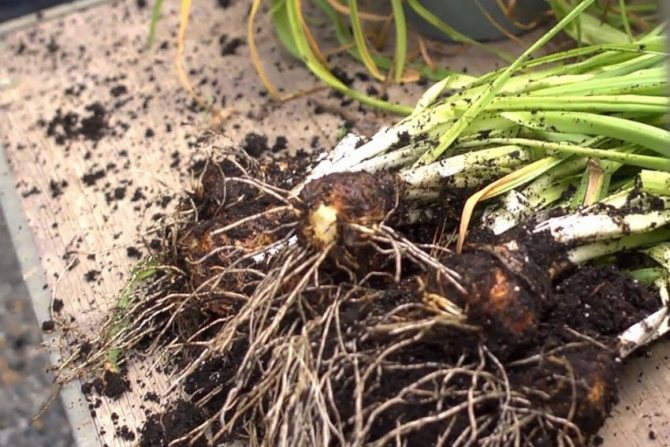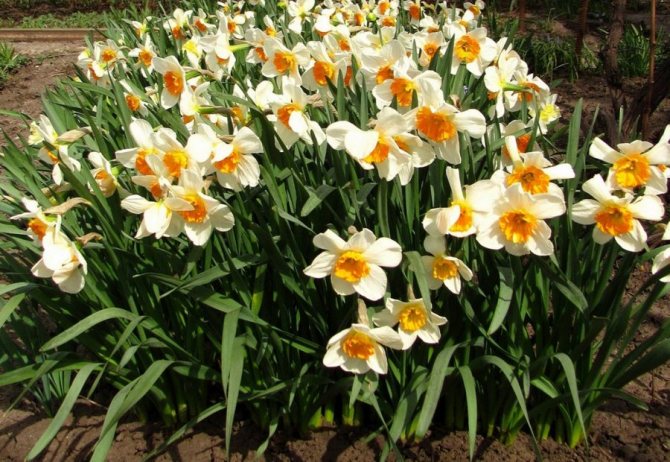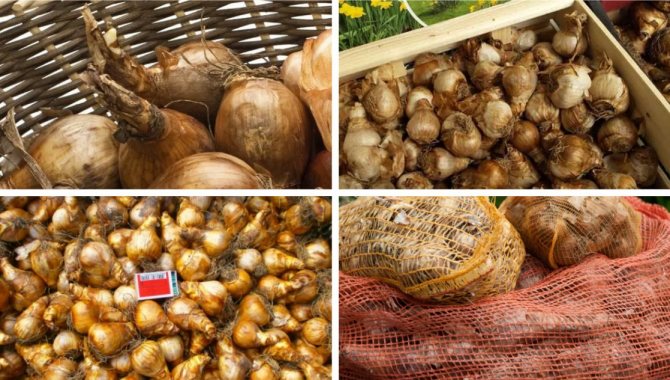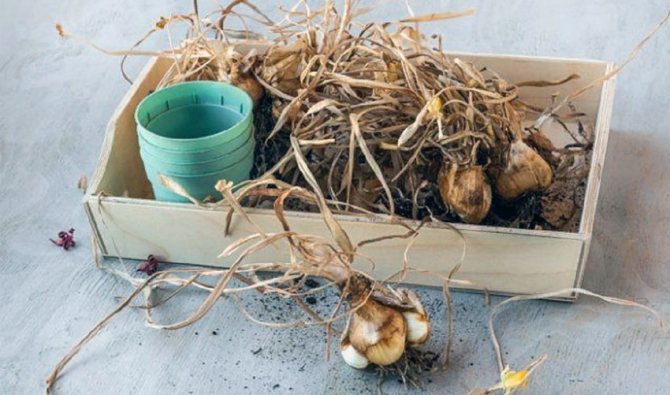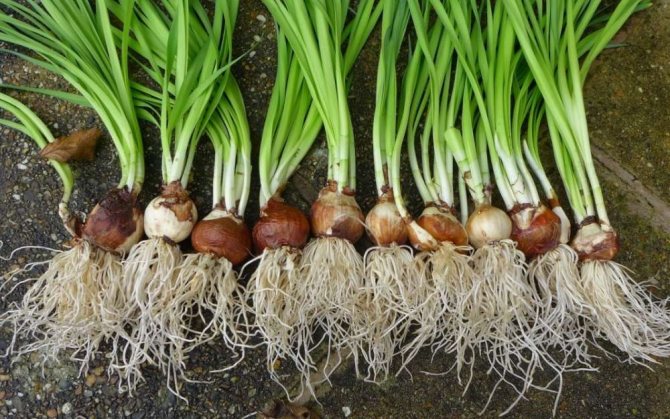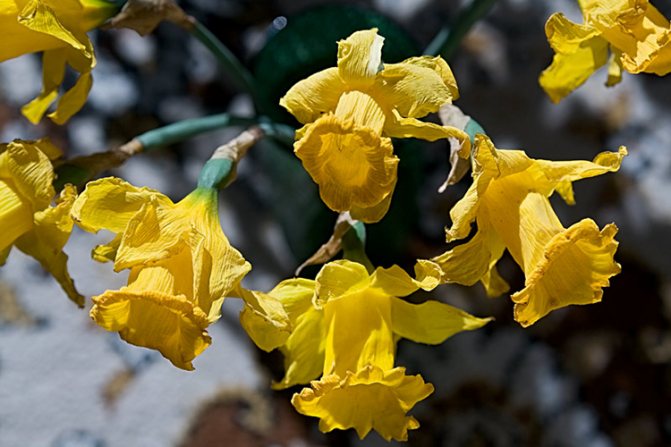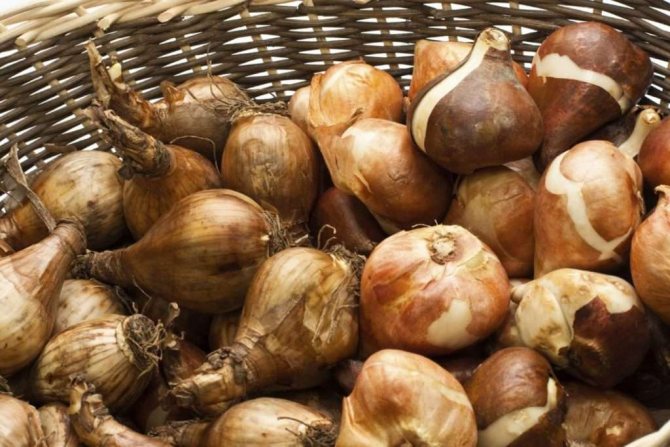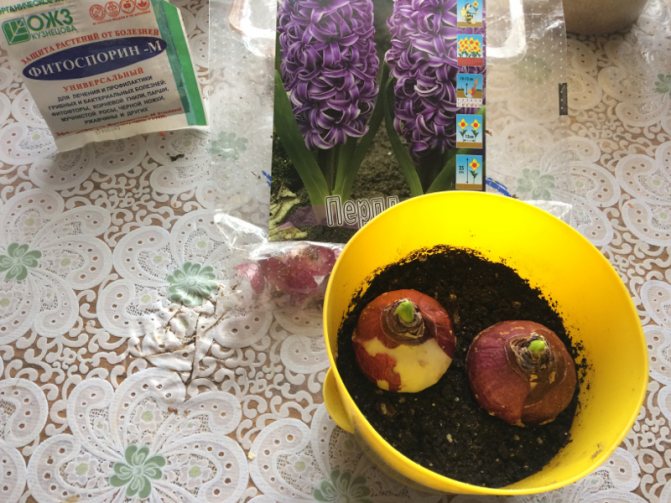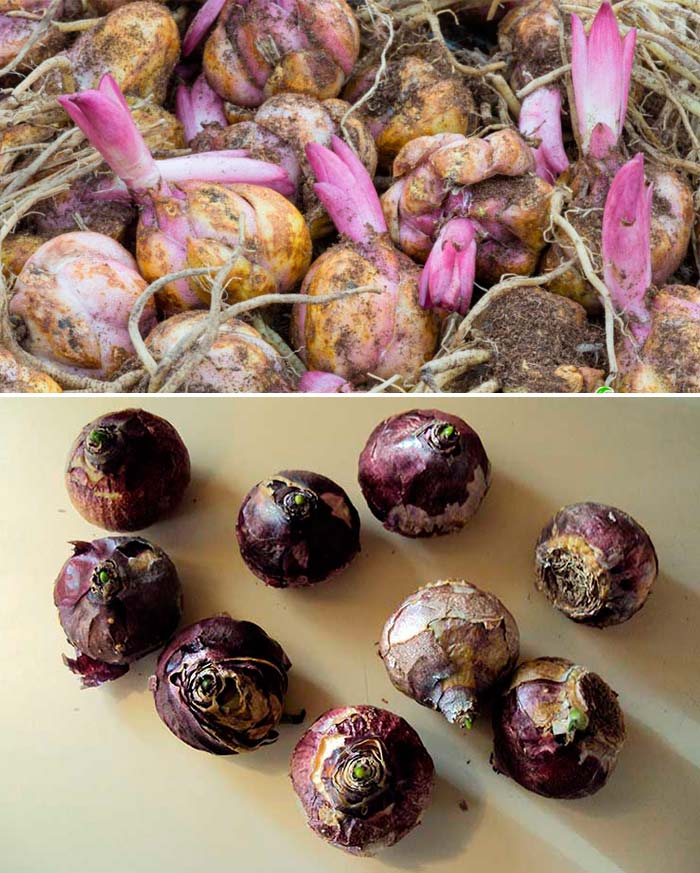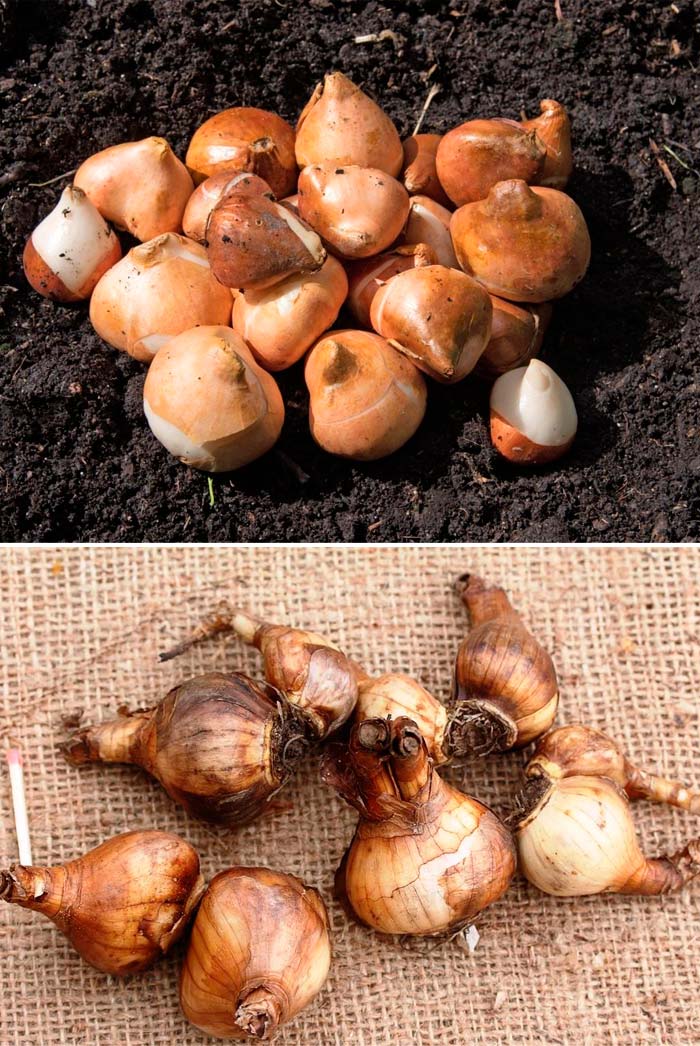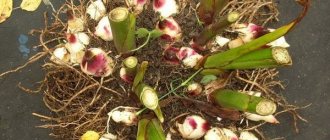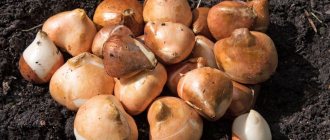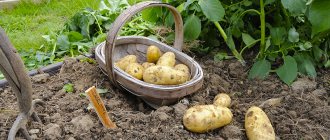To determine when it is time to dig up daffodil bulbs, it is important to understand why this process is necessary. Not all flowers that have bulbs need to be dug out at the same time. In the case of narcissus, the plant dormant period does not occur completely. Even after the bulb is removed from the soil, already without greenery, it will continue to breathe and lose moisture. Therefore, there is little time for a culture transplant - only one or two months.
Depending on the variety, daffodils can grow 2-4 bulbs in one season, due to which they multiply. The required ground temperature for planting flower buds is + 16-18 ° C, but a lot of free space is also needed for the roots to receive enough nutrients. If you plant the bulbs too closely, then they are crushed and every year they will be less pleasing with flowering. Therefore, digging up a culture with subsequent planting allows not only to propagate the plant, but also to preserve the ability to form a flower.
General information about the daffodil plant
The primrose forms an egg-shaped bulb, the entire area of which is covered with brown scales. In one place the plant grows for more than one year, children are formed around it, which during the onset of the next growing season become independent crops.
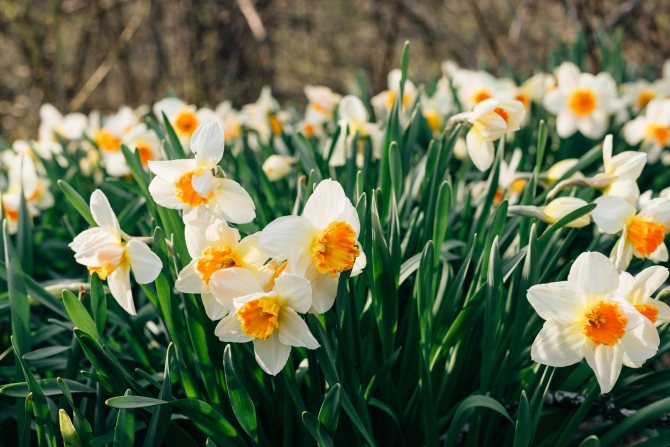
The appearance of daffodils
The leaf plates grow from the root, their shape is oblong and narrow, the color is gray-green. With the onset of April-May, the plant produces a long peduncle, at the top of which a flower begins to form. As a rule, the diameter of the flower ranges from 4-6 cm. The duration of flowering is usually about two weeks.


This is what a single flower looks like
Note! Daffodils belong to the category of medicinal plants, as their flowers contain a high concentration of essential oils, and the bulbs contain alkaloids. These ingredients are used in traditional and folk medicine, as well as in perfumery.
Autumn transplant
This is the best time when digging up daffodils for transplanting is not only possible, but also necessary. The optimal period is mid-August. At the same time, professionals recommend preparing the garden in advance and planting the bulbs immediately after you dug up the plant and separated the baby from it. This planting protects the bulb from drying out and makes it possible to quickly take root and develop a powerful root system even before the cold weather. When the procedure is carried out on time, the plants winter well and bloom the next year.
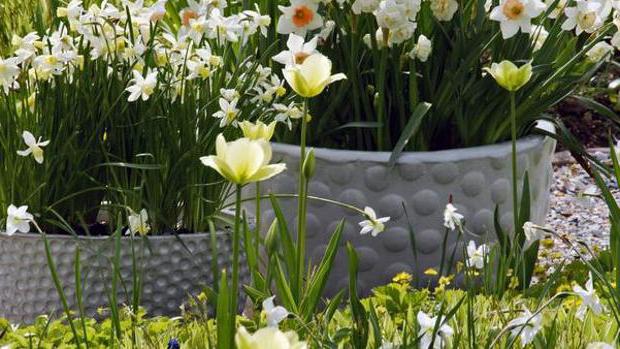

Features of growing daffodils
Before figuring out when to dig up daffodil bulbs, you need to familiarize yourself with the generalized features of growing this plant in your garden.
When to dig up tulip bulbs after flowering
Narcissus belongs to unpretentious plants in growing and caring, but there are subtleties that you should definitely know. Plant the bulbs in a place protected from drafts and with plenty of sunlight.
Important! Planting daffodils should not be carried out in areas where other bulbous crops or perennial chrysanthemums grew a year earlier. The most suitable place is after legumes and cucumbers.
The plant loves neutral soil, which was previously fertilized with rotted humus. If the soil is alkaline, then dolomite flour must be added to its composition; with increased acidity, the indicators are normalized with wood ash. Sand and peat are added to clay soil, and mineral / organic fertilizers and black soil are added to sandy soil.
The place for transplanting daffodils should be open and dry, since high humidity can provoke the development of fungal diseases.
Frequency of digging up daffodils
Narcissus is classified as a perennial bulbous plant. It is distinguished by beautiful large inflorescences with a bright yellow color.
It is recommended to do a daffodil transplant once every 3 to 5 years. An indicator that it is necessary is a weak flowering of plants. The bulbs of these flowers are already weakened due to the appearance of "babies". Therefore, they must be seated.
Especially beautiful and rare varieties of these flowers should be replanted every 2 - 3 years (often not necessary).
When the plans do not include the cultivation of daffodils, but only need their lush flowering, you can transplant the bulbs every year. In this case, the formation of small bulbs (children) will not occur. And all the nutrients will be directed to the development of the stem, leaves and inflorescences.
But frequent transplants have their drawbacks: the plant may stop blooming within a few years, or the buds will be too small.
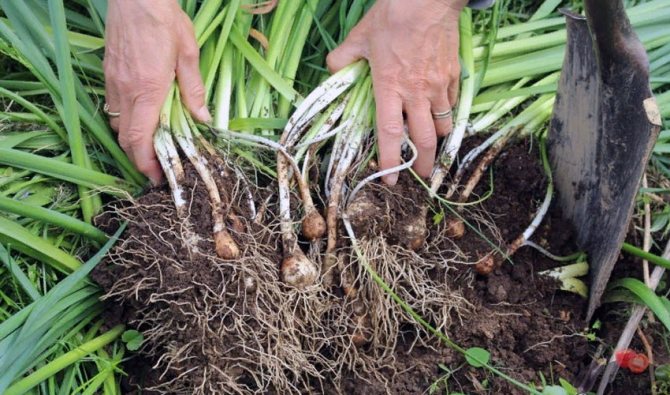

Ideal time to harvest bulbs
When to dig up hyacinths after flowering
A gardener for himself must always clearly know when to dig and plant daffodils. For example, if the daffodils began to bloom with not such large flowers as before, then it's time to plant the bush. You can dig up the bulbs in dry and warm weather.
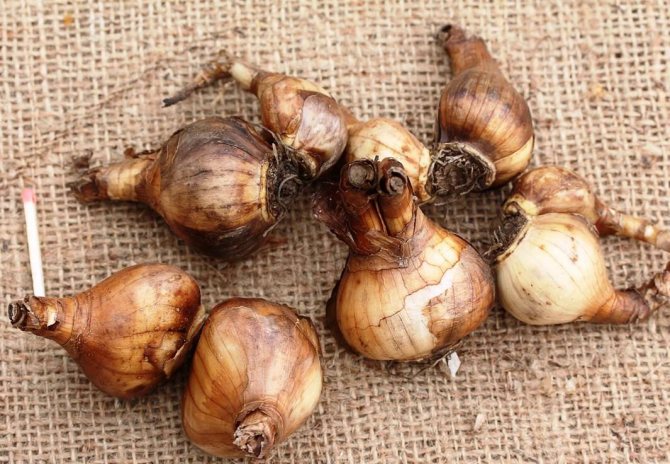

Daffodil bulbs
The algorithm of actions looks like the following:
- Remove the bush from the soil and clean. Conduct a thorough inspection and analysis of the quality of the seed.
- Damaged, soft tubers must be discarded.
- In conclusion, it remains to divide the tuber colony and put them in the fresh air to dry.
Common daffodils grow in one place for at least 5-7 years, it is strongly not recommended to disturb them before. But hybrid varieties, a characteristic feature of which is the presence of large terry inflorescences, need a high agricultural background, so they need to be transplanted every year.
Description
Before proceeding directly to digging up daffodils, you should dwell on the features of their cultivation and reproduction.
The root of the flowers is a bulb. After the annual flowering, the aboveground part dries up and dies. The bulb, in turn, is well stored in the soil and retains its qualities until the next season.
Daffodils have a different multiplication factor, which significantly depends on the choice of varieties. Usually 4 new plants are formed in one year of growth.
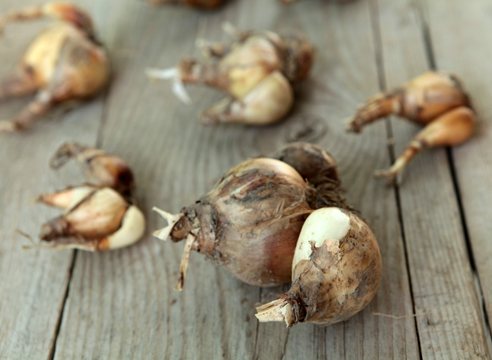

Daffodil bulbs
It is recommended to dig up daffodils for the purpose of reproduction after 3-4 years of growth. By that time, a whole family is formed on the basis of one onion. The plants themselves become cramped and a lack of nutrients begins. This is expressed in the grinding of flowers and their loss of their healthy appearance.
If the cultivation of daffodils is not included in the plans of flower growers, then the bulbs are dug up annually. At the same time, they retain their large size and do not give offspring. Usually, these flowers are somewhat larger and more beautiful than those grown for propagation.
What varieties of daffodils daffodils do not need to be dug in the fall
When to dig out hazel grouses after flowering and how to store before planting
Breeders annually present to the public a large number of new varieties, most of them no longer need to be transplanted annually.The most popular types of daffodils are:
- Trumpet or Tubular;
- Bunch-flowered or Multi-flowered;
- Large-cupped or Large-cupped;
- Jonquilla or Jonquilla;
- Small-cupped or Small-crowned;
- Cyclamineus or Cyclameniform;
- Triandrus or Triandrus.
To grow healthy and hardy plants, you need to pay special attention to the quality of the acquired planting material. The ideal option is to buy bulbs from breeders if you cannot grow them yourself, or buy from neighbors.
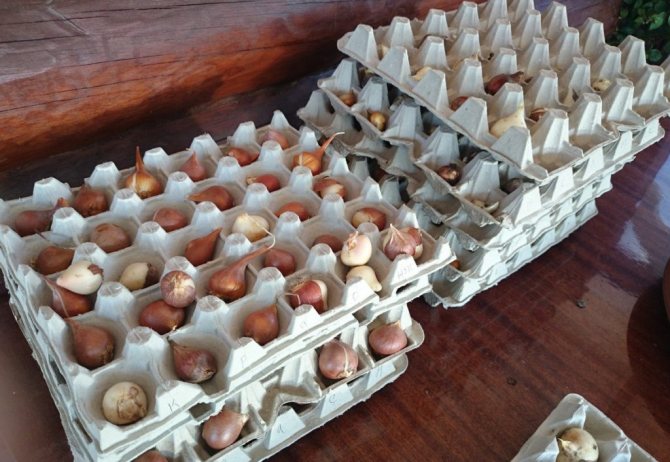

An example of storing a bulb in a basement
Summer transfer
The most important thing is to wait for the plants to bloom. When to dig up daffodils for transplanting, I want to ask every time you see a beautiful flowering plant from your friends in the garden. However, you should not immediately start digging up the plant and separating it from her children. In this case, most likely, the whole color will die, the plant will shed its foliage, and next year it will only gain strength. But in a year it will be indistinguishable from its fellows planted in the fall.


How to properly prepare daffodil bulbs for storage
In order for the planting material to be stored properly, it must be properly prepared. The preparation features are as follows:
- The first stage of preparation is thorough and correct drying. This should be done outdoors or under a canopy in a well-ventilated area. As a rule, this stage takes about a week. During this time, the tubers should be covered with a dense film.
- Accreted tubers must be divided without fail. If the “babies” are small and too tightly attached to the “mother”, then it is better not to touch them. They are not yet ready to lead an independent life.
- After drying, the seed is sorted. For storage, healthy, dense and strong bulbs are selected, on which there are no signs of the development of diseases or insect damage.
- Bulbs that have not been selected should be disposed of immediately. The best option is to burn them.
- The selected material is then sorted by size. This is done in order to make the autumn planting more convenient.
Unfortunately, a favorable environment for the life and reproduction of insects is created in the planting material, especially onion flies love the tubers. To get rid of them, it is recommended to place the bulbs in water with a temperature of about +45 degrees for several hours, and then dry thoroughly.
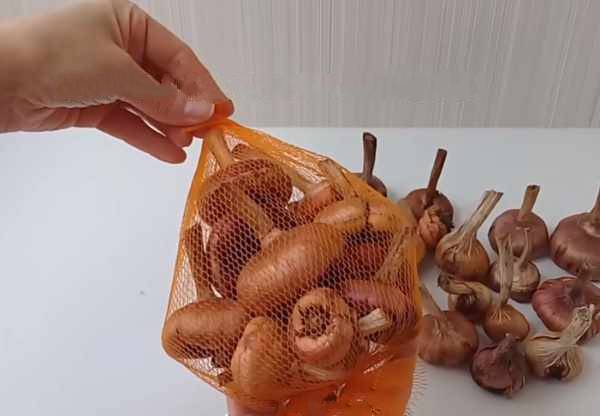

Hanging daffodil bulbs
Planting dates for daffodils
Spring planting of daffodils is possible if the bulbs were stored in winter for 2-3 months at low above zero temperatures - 1-3 ºC, otherwise the bulbs will not root. In addition, it is better to plant thermophilic varieties in spring. In the southern regions, daffodils are planted in March, as soon as the snow melts, in the middle lane - not earlier than mid-April, or even at the end of the month. Daffodils root best at a temperature of 5-7 ºC.
But the best time for planting daffodils is autumn, no later than September, in a warm area - at the end of the month, and small bulbs can be planted in August or even July, so that they have time to root and grow. If stored until September, they may simply dry out.
In autumn, wait for the soil to cool to 8-10 ºC before planting.
How to store daffodil bulbs at home
After digging up the bulbs, they need to be put in the open air for several hours. Do not allow direct sunlight to fall on the planting material, this is fraught with the appearance of burns. As soon as the soil has dried and began to crumble from the tubers, they can be transferred to a cool and well-ventilated room (the air temperature should not exceed +20 degrees). Gardeners use the following methods for storing planting material:
- In dry cellars in spacious wooden boxes.You can lay the tubers in layers, but be sure to put thick newspaper sheets between them.
- Quite often, the planting material is hung in a nylon, tulle or canvas bag.
- If there are few bulbs, then they can be planted in the ground, having previously prepared a flower pot. For the winter, containers must be stored in a cool room.
- If the grower has a heated balcony, then the seed can be stored there.


Storing daffodil bulbs in pots
Some people mistakenly think that tubers are good for refrigeration. This is not recommended for the main reason - the tubers quickly accumulate dampness, from which they begin to hurt.
Important! Duration of storage of seed is no more than 3-4 months.
How to choose
The purchase of planting material often occurs at various spring sales, where rare varieties of flowers can be purchased for little money. But at the same time, the chances of buying an expired or low-quality product increase, the germination of which will be a big question.
When buying daffodil bulbs, first of all pay attention to their structure. It should not be soft and loose. Overdried and wrinkled, weakened planting material will not be able to give full-fledged shoots.
If the bulbs are still able to sprout, they will need a lot of attention to ensure that the sprouts do not die as soon as they are born.
It is most correct to acquire daffodils only 3 months after they have faded. During this time, the bulbs are strong enough to transfer storage normally before planting.
Daffodils should not be purchased:
- in the spring;
- dug out of the ground without pruning during flowering, or after a short time after;
- bulbs, consisting of one large and several small parts;
- bulbs in the initial stage of germination.
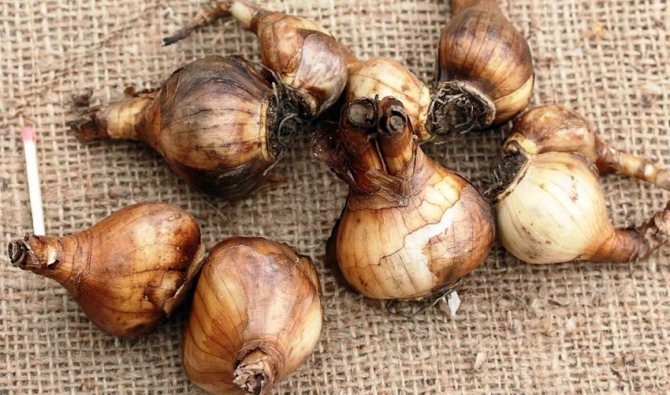

Before planting in open ground, it is necessary to reject the material. Bulbs with damage, signs of disease and decay should not be planted. They will die on their own and infect neighboring plants.
Healthy material must be disinfected, for which it should be held for 30 minutes in a fungicide solution (3%) or in potassium permanganate (1%).
Treatment of tubers from diseases and pests
Daffodils, like most other bulbous plants, are susceptible to the development of fungal diseases:
- Penicillous rot leads to irreversible consequences. The tubers rot quickly enough that the gardener does not even have time to do anything. Infection occurs through infected rain / irrigation water or if the bulbs have been stored at low temperatures.
- Sclerotinosis is accompanied by the formation of black dots on the bulbs, around which a dense white bloom forms a little later. The bulbs affected by the disease die and do not emerge.
- Botrytis (among gardeners it is called gray bloom). It is difficult to identify the disease, since during its development, black spots form under the scales on the tuber. Infection occurs in most cases through the soil and through contact with infected bulbs.
- Fusarium or rotting of the bottom. The pathogen infects the plant through the roots. The bulb becomes soft with the progression of the disease. A white bloom also forms between the dark brown scales. If it is detected in a timely manner, the development of the disease can be stopped.
Note! To prevent bulbs from rotting, the gardener must follow certain safety measures. Before removing them for the winter, you need to thoroughly disinfect. To do this, the bulbs are soaked for 20-30 minutes in a weak solution of potassium permanganate (manganese).


The appearance of diseased daffodil bulbs
Disinfection of daffodil bulbs in autumn
Tubers can be processed not only in the fall after digging in preparation for storage, but also before planting.
| Pests / diseases | Remedy for the fight | Terms of use |
| Daffodil fly |
|
|
| Nematodes | "Nemaphos", "Carbation" | Thorough processing of bulbs and then plants |
| Against all fungal diseases | Universal remedy - Bordeaux liquid | Process the bulbs and then the plants as soon as the first leaves appear. |
| "Maxim" | Soak the bulbs for about half an hour before planting. |
The approach to dealing with disease and pest attacks must be comprehensive. Of great importance is not only the correct treatment of tubers, but also the prevention of the development of pathologies.
Daffodils are unpretentious and cute plants that, during their flowering, delight the eye with bright colors. Due to the large number of advantageous features, this flowering crop grows in almost every household plot.
Transplant after flowering
From the above, it is obvious that flowering plants should not be touched. Then let's consider when to dig up daffodils after flowering. It must be remembered that this is a perennial plant, which means that the first three years are the formation of the bulb, a certain number of flower buds are laid. That is why it is not recommended to dig it out during the specified period.
Now let's figure out when to dig up the daffodils after flowering. The optimal time is 50 days after the end of flowering. Just by this period, the growth and development of the bulb ends. Outwardly, this can be easily determined: the bush begins to fall apart, and the leaves turn slightly yellow. Usually the first half of July is suitable for this, but this period varies slightly for each region. However, do not wait until the plant is completely dry and dry. Then it will be difficult for you to look for the bulbs, there is a great risk of cutting them with a shovel.
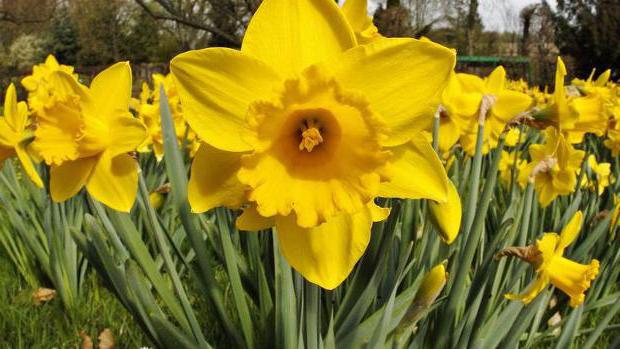

Digging Precautions
Basic recommendations for the safe extraction of rhizomes from the soil:
- It is necessary to dig up the bulbs of plants together with a large clod of earth so as not to harm them.
- It is undesirable to use a large garden shovel as it is likely to damage the roots. Better to use a tool designed for indoor plants.
- Under no circumstances should you cut the roots.
- After the tubers have dried up a little, you need to discard excess soil and start dividing the bulbs. This part of the plant is quite sensitive, so this procedure must be approached with great care.
Attention! In order to remove excess soil, you should not resort to the use of water. If, of all the tubers dug for transplant, at least one onion is sick, it is highly likely that all the others will be infected.
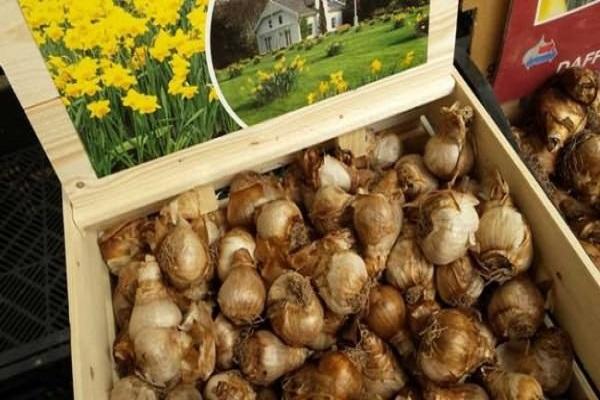

When is it time to dig
When the time has come for transplanting daffodils, in order to avoid the lack of flowering in the new season, it is necessary to accurately determine the time for digging up the tubers.
Unlike other flowering plants, daffodils do not have a specific time for the dormant stage, that is, a period when all processes inside the flower slow down significantly. Therefore, the owners of this plant do not have to wait for a specific day to start the transplant procedure.
See also
Description of daffodil varieties Sir Winston Churchill, planting and care rulesRead
However, it is not recommended to do this immediately after the buds are in bloom. The best time is considered the moment when the leaves of the daffodils completely turn yellow. This usually occurs in the second half of June and continues until early July.
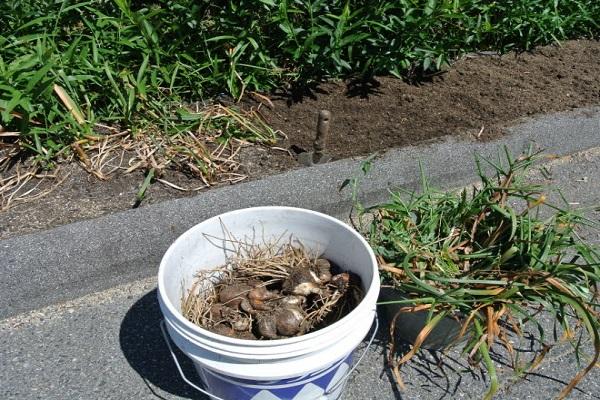

Caring for daffodils after planting
Caring for daffodils in the fall serves only one purpose: the earliest formation of roots in the bulbs. Water the site as needed, but if it rains, then artificial moisture will not be needed.Moreover: if precipitation is frequent and heavy, you will have to cover the planting with a film so that the bulbs do not get soaked in liquid mud. After watering or rain, you need to slightly loosen the surface of the site so that air can flow to the bulbs.
It is advisable to cover the daffodils for the winter, especially if severe frosts occur in your area. As soon as it gets colder, loosen the soil in the area and then cover it with sawdust, straw, dry leaves, peat or wood ash 10-15 cm thick. You can cover the planting with spunbond or lutrasil.
4.3333333333333 Rating 4.33 (3 Votes)
- Back to
- Forward




